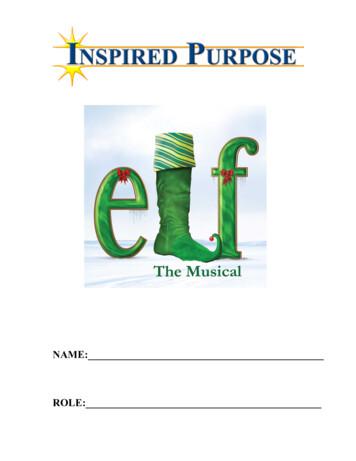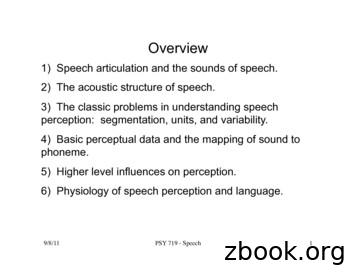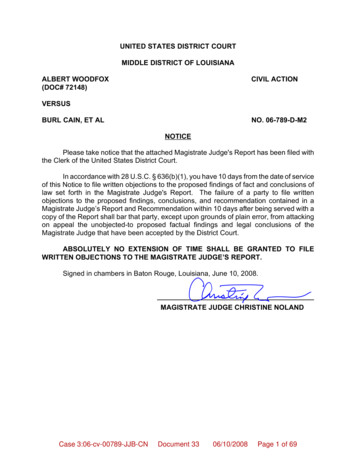Digital Speech Processing - UC Santa Barbara
Digital Speech ProcessingProfessor Lawrence RabinerUCSBDept. of Electrical and ComputerEngineeringJan-March 20121
Course DescriptionThis course covers the basic principles of digital speech processing:– Review of digital signal processing– Fundamentals of speech production and perception– Basic techniques for digital speech processing: short - time energy, magnitude, autocorrelationshort - time Fourier analysishomomorphic methodslinear predictive methods– Speech estimation methods speech/non-speech detectionvoiced/unvoiced/non-speech segmentation/classificationpitch detectionformant estimation– Applications of speech signal processing Speech coding Speech synthesis Speech recognition/natural language processingA MATLAB-based term project will be required for all students takingthis course for credit.2
Course Information Textbook: L. R. Rabiner and R. W. Schafer,Theory and Applications of Digital SpeechProcessing, Prentice-Hall Inc., 2011 Grading:––––HomeworkTerm ProjectMid - Term ExamFinal Exam20%20%20%40% Prerequisites: Basic Digital Signal Processing,good knowledge of MATLAB Time and Location: Tuesday, Thursday, 10:00am to 11:20 am, Phelps 1437. Course Website:www.ece.ucsb.edu/Faculty/Rabiner/ece259 Office Hours: Tuesday, 1:00-3:00 pm3
Web Page for Speech CourseClick onDigitalSpeechProcessingCourseon left-sidepanel4
Web Page for Speech CourseDownloadcourselecture slides5
Web Page for Speech CourseCourselecture slides(6-to-page)6
Web Page for Speech CourseDownloadhomeworkassignments,speech files7
Web Page for Speech CourseDownloadMATLAB (.m)files; ExamineProjectSuggestions8
Course ReadingsRequired Course Textbook: L. R. Rabiner and R. W. Schafer, Theory andApplications of Digital Speech Processing, Prentice-HallInc., 2011Recommended Supplementary Textbook: T. F. Quatieri, Principles of Discrete - Time SpeechProcessing, Prentice Hall Inc, 2002Matlab Exercises: C. S. Burrus et al, Computer-Based Exercises for SignalProcessing using Matlab, Prentice Hall Inc, 1994 J. R. Buck, M. M. Daniel, and A. C. Singer, ComputerExplorations in Signals and Systems using Matlab,Prentice Hall Inc, 20029
Recommended References J. L. Flanagan, Speech Analysis, Synthesis, and Perception,Springer -Verlag, 2nd Edition, Berlin, 1972J. D. Markel and A. H. Gray, Jr., Linear Prediction of Speech,Springer-Verlag, Berlin, 1976B. Gold and N. Morgan, Speech and Audio Signal Processing, J.Wiley and Sons, 2000J. Deller, Jr., J. G. Proakis, and J. Hansen, Discrete - TimeProcessing of Speech Signals, Macmillan Publishing, 1993D. O’Shaughnessy, Speech Communication, Human and Machine,Addison-Wesley, 1987S. Furui and M. Sondhi, Advances in Speech Signal Processing,Marcel Dekker Inc, NY, 1991R. W. Schafer and J. D. Markel, Editors, Speech Analysis, IEEEPress Selected Reprint Series, 1979D. G. Childers, Speech Processing and Synthesis Toolboxes, JohnWiley and Sons, 1999K. Stevens, Acoustic Phonetics, MIT Press, 1998J. Benesty, M. M. Sondhi and Y. Huang, Editors, Springer Handbookof Speech Processing and Speech Communication, Springer, 2008.10
References in Selected Areas of SpeechProcessingSpeech Coding: A. M. Kondoz, Digital Speech: Coding for LowBit Rate Communication Systems-2nd Edition,John Wiley and Sons, 2004 W. B. Kleijn and K. K. Paliwal, Editors, SpeechCoding and Synthesis, Elsevier, 1995 P. E. Papamichalis, Practical Approaches toSpeech Coding, Prentice Hall Inc, 1987 N. S. Jayant and P. Noll, Digital Coding ofWaveforms, Prentice Hall Inc, 198411
References in Selected Areas of Speech ProcessingSpeech Synthesis: T. Dutoit, An Introduction to Text - To-SpeechSynthesis, Kluwer Academic Publishers, 1997 P. Taylor, Text-to-Speech Synthesis, CambridgeUniversity Press, 2008 J. Allen, S. Hunnicutt, and D. Klatt, From Text toSpeech, Cambridge University Press, 1987 Y. Sagisaka, N. Campbell, and N. Higuchi,Computing Prosody, Springer Verlag, 1996 J. VanSanten, R. W. Sproat, J. P. Olive and J.Hirschberg, Editors, Progress in SpeechSynthesis, Springer Verlag, 1996 J. P. Olive, A. Greenwood, and J. Coleman,Acoustics of American English, Springer Verlag,121993
References in Selected Areas of SpeechProcessingSpeech Recognition: L. R. Rabiner and B. H. Juang, Fundamentals ofSpeech Recognition, Prentice Hall Inc, 1993 X. Huang, A. Acero and H-W Hon, SpokenLanguage Processing, Prentice Hall Inc, 2000 F. Jelinek, Statistical Methods for SpeechRecognition, MIT Press, 1998 H. A. Bourlard and N. Morgan, ConnectionistSpeech Recognition-A Hybrid Approach, KluwerAcademic Publishers, 1994 C. H. Lee, F. K. Soong, and K. K. Paliwal,Editors, Automatic Speech and SpeakerRecognition, Kluwer Academic Publisher, 1996 13
References in Digital Signal Processing A. V. Oppenheim and R. W. Schafer, Discrete Time Signal Processing, 3rd Ed., Prentice-HallInc, 2010 L. R. Rabiner and B. Gold, Theory andApplication of Digital Signal Processing, PrenticeHall Inc, 1975 S. K. Mitra, Digital Signal Processing-AComputer-Based Approach, Third Edition,McGraw Hill, 2006 S. K. Mitra, Digital Signal Processing LaboratoryUsing Matlab, McGraw Hill, 199914
The Speech StackSpeech Applications — coding, synthesis,recognition, understanding, verification,language translation, speed-up/slow-downSpeech Algorithms— speech-silence(background), voiced-unvoiced, pitchdetection, formant estimationSpeech Representations — temporal,spectral, homomorphic, LPCFundamentals — acoustics, linguistics,pragmatics, speech production/perception15
Digital Speech ProcessingAbility to implementtheory and conceptsin working code(MATLAB, C, C )Basic understandingof how theory isappliedMathematics,derivations, signalprocessingNeed to understand speech processing at allthree levels16
Course Outline – ECE 259A – Speech Processing Jan 10 Jan 12 Jan 17 Jan 19 Jan 24 Jan 26 Jan 31 Feb 2 Feb 7 Feb 9 Feb 14 Feb 16 Feb 21 Feb 23 Feb 28 Mar 1 Mar 6 Mar 8 Mar 13 Mar 15 Mar 20 -Lecture 1,Basic Course Material; Introduction to Digital Speech ProcessingLecture 2a, Review of DSP FundamentalsLecture 2b, Review of DSP FundamentalsLecture 3a, Acoustic Theory of Speech ProductionLecture 3b, Lecture 4, Speech Perception—Auditory ModelsLecture 5, Sound Propagation in the Vocal Tract -- Part 1Lecture 6, Sound Propagation in the Vocal Tract -- Part 2Lecture 7, Time Domain Methods -- Part 1Lecture 8, Time Domain Methods -- Part 2Lecture 9, Frequency Domain Methods -- Part 1Lecture 10-11, Frequency Domain Methods -- Part 2Mid - Term ExamLecture 12a, Homomorphic Speech Processing -- Part 1Lecture 12b, Homomorphic Speech Processing -- Part 2Lecture 13, Linear Predictive Coding (LPC) -- Part 1Lecture 14, Linear Predictive Codeing (LPC) -- Part 2Lecture AlgorithmsLecture 15, Speech Waveform Coding -- Part 1Lecture 16, Speech Waveform Coding -- Part 2Term Project Presentations (8-12 noon)Final Exam (8 am-11 am)17
Other Potential Topics forDiscussion/Term Projects Sinusoidal modeling of speech Speech modification and enhancement—slowing down and speeding up speech, noisereduction methods Speaker verification methods Music coding including MP3 and AACstandards-based methods Pitch detection methods18
Term Project All registered students are required to do a term project.This term project, implemented using Matlab, must be aspeech or audio processing system that accomplishes asimple or even a complex task—e.g., pitch detection,voiced-unvoiced detection, speech/silence classification,speech synthesis, speech recognition, speakerrecognition, helium speech restoration, speech coding,MP3 audio coding, etc. Every student is also required to make a 10-minutePower Point presentation of their term project to theentire class. The presentation must include:– A short description of the project and its objectives– An explanation of the implemented algorithm and relevant theory– A demonstration of the working program – i.e., results obtainedwhen running the program19
Suggestions for Term ch detector – time domain, autocorrelation, cepstrum, LPC, etc.Voiced/Unvoiced/Silence detectorFormant analyzer/trackerSpeech coders including ADPCM, LDM, CELP, Multipulse, etc.N-channel spectral analyzer and synthesizer – phase vocoder, channelvocoder, homomorphic vocoderSpeech endpoint detectorSimple speech recognizer – e.g. isolated digits, speaker trainedSpeech synthesizer – serial, parallel, direct, latticeHelium speech restoration systemAudio/music coderSystem to speed up and slow down speech by arbitrary factorsSpeaker verification systemSinusoidal speech coderSpeaker recognition systemSpeech understanding systemSpeech enhancement system (noise reduction, post filtering, spectralflattening)20
MATLAB Computer ProjectThe requirements for this project are a shortdescription of the problem containingrelevant mathematical theory and objectivesof the project, a listing (with sufficientdocumentation and comments) of theprogram, and a demonstration that theprogram works properly.21
speech or audio processing system that accomplishes a simple or even a complex task—e.g., pitch detection, voiced-unvoiced detection, speech/silence classification, speech synthesis, speech recognition, speaker recognition, helium speech restoration, speech coding, MP3 audio coding, etc. Every student is also required to make a 10-minute
4 santa: ungodly santa & elves: happy all the time santa: when they sing until they’re bluish, santa wishes he were jewish, cause they’re santa & elves: happy all the time santa: i swear they're santa & elves: happy all the time santa: bizarrely happy all the time (elves ad lib: "hi santa" we love you santa" etc.) popsy:
Lecture 1 Introduction to Digital Speech Processing 2 Speech Processing Speech is the most natural form of human-human communications. Speech is related to language; linguistics is a branch of social science. Speech is related to human physiological capability; physiology is a branch of medical science.
The complete set of MATLAB Speech Processing Apps is made available to students and instructors via MATLAB Central, File Exchange, on the MathWorks website, including: -all the code that is required to run the complete set of Speech Processing Apps -an extensive set of speech and audio files for processing
SANTA ANA CITY COUNCIL Vicente Sarmiento Mayor vsarmiento@santa-ana.org David Penaloza Mayor Pro Tem, Ward 2 dpenaloza@santa-ana.org Thai Viet Phan Ward 1 tphan@santa-ana.org Jessie Lopez Ward 3 jessielopez@santa-ana.org Phil Bacerra Ward 4 pbacerra@santa-ana.org Johnathan Ryan Hernandez Ward 5 jryanhernandez@santa-ana.org Nelida Mendoza
Digital Speech Processing Need to understand the nature of the speech signal, and how dsp techniques, communication technologies, and information theory methods can be applied to help solve the various application scenarios described above – most of the course will concern itself with speech signal processing — i.e., converting one type of
speech 1 Part 2 – Speech Therapy Speech Therapy Page updated: August 2020 This section contains information about speech therapy services and program coverage (California Code of Regulations [CCR], Title 22, Section 51309). For additional help, refer to the speech therapy billing example section in the appropriate Part 2 manual. Program Coverage
9/8/11! PSY 719 - Speech! 1! Overview 1) Speech articulation and the sounds of speech. 2) The acoustic structure of speech. 3) The classic problems in understanding speech perception: segmentation, units, and variability. 4) Basic perceptual data and the mapping of sound to phoneme. 5) Higher level influences on perception.
ALBERT WOODFOX CIVIL ACTION (DOC# 72148) VERSUS BURL CAIN, ET AL NO. 06-789-D-M2 MAGISTRATE JUDGE’S REPORT This matter is before the Court on the original and amended petitions for writ of habeas corpus (R. Doc. 1 and 12) filed by petitioner, Albert Woodfox (“Woodfox”). The State has filed an answer and a memorandum in support of answer (R. Docs. 21 and 22), to which Woodfox has filed a .























